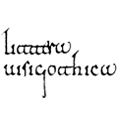Teaching Palaeography II: teaching materials
I am one for sharing -getting feedback allows us to improve-, so I have uploaded most of my teaching materials (Medieval Palaeography - BA in History) to my Academia.edu webpage. What follows is a summary of the things you will find in there.
Since I am currently teaching at the Universidad de Salamanca, what I do is Spanish/Iberian Medieval Palaeography (I am planning to expand that to other European scripts, particularly Merovingian and Insular :) ) and, therefore, all the following resources are in Spanish. If you are reading this, you are either a Spanish scholar or someone interested in Spanish Palaeography and able to read it. If you need help with a translation, do let me know.
Be aware this is an undergraduate course and these materials are adapted to that level.
Presentation: This is the PowerPoint presentation that links all the materials included in my 3-week class on Medieval Palaeography and Diplomatics. Since it is a general summary, here you will find the most relevant topics and images to contextualise those most significant aspects developed in each lesson.
Lesson 1: Palaeography: A general approach to the field identifying its three methods/aims – reading, analysing and contextualising manuscripts – with a basic vocabulary/terminology at the end.
Lesson 2: Medieval abbreviations: Types of medieval abbreviations (with examples) and their origin.
Lesson 3: Roman and National scripts (with examples and a short introduction to graphic diversity in the Early Medieval period) and Visigothic script (everything you ever wanted to know on Visigothic script– on its genetic, chronological and geographic origin, its name, types and characteristics, evolution and regional variants – plus exercises).
Lesson 4: Graphic homogenisation and Caroline minuscule, including a short introduction on Charlemagne, the basic graphic characteristics of Caroline minuscule, its evolution and adaptation/transformation in Iberia, also with exercises.
Lesson 5: Graphic division and Gothic scripts, with a very short but clarifying list on types of scripts and their context.
Lesson 6: Medieval Diplomatics: A general approach and explanation of its four methods – documentary genesis, tradition, structure, and edition – with some examples, proposals, further references and resources.
I will gladly welcome advice to improve these resources, and please do let me know if you are to use them on class (measuring impact and all that…).
by A. Castro

